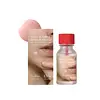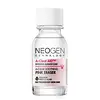What's inside
What's inside
 Key Ingredients
Key Ingredients

 Benefits
Benefits

 Concerns
Concerns

 Ingredients Side-by-side
Ingredients Side-by-side

Water
Skin ConditioningAlcohol
AntimicrobialCalamine
AbsorbentGlycerin
HumectantTitanium Dioxide
Cosmetic ColorantButylene Glycol
HumectantSalicylic Acid
MaskingPanthenol
Skin ConditioningDimethyl Sulfone
SolventCeramide NP
Skin ConditioningGlycolic Acid
BufferingCentella Asiatica Extract
CleansingTartaric Acid
BufferingMalic Acid
Buffering1,2-Hexanediol
Skin ConditioningCamellia Sinensis Leaf Extract
AntimicrobialLactic Acid
BufferingChamaecyparis Obtusa Leaf Extract
Skin ConditioningUlmus Davidiana Root Extract
Skin ConditioningPueraria Lobata Root Extract
HumectantPinus Palustris Leaf Extract
TonicOenothera Biennis Flower Extract
AstringentWater, Alcohol, Calamine, Glycerin, Titanium Dioxide, Butylene Glycol, Salicylic Acid, Panthenol, Dimethyl Sulfone, Ceramide NP, Glycolic Acid, Centella Asiatica Extract, Tartaric Acid, Malic Acid, 1,2-Hexanediol, Camellia Sinensis Leaf Extract, Lactic Acid, Chamaecyparis Obtusa Leaf Extract, Ulmus Davidiana Root Extract, Pueraria Lobata Root Extract, Pinus Palustris Leaf Extract, Oenothera Biennis Flower Extract
Water
Skin ConditioningAlcohol Denat.
AntimicrobialCalamine
AbsorbentGlycerin
HumectantMelaleuca Alternifolia Leaf Oil
AntioxidantAsiaticoside
AntioxidantMadecassic Acid
Skin ConditioningAsiatic Acid
Skin ConditioningMadecassoside
AntioxidantCamellia Sinensis Leaf Extract
AntimicrobialOpuntia Coccinellifera Fruit Extract
Skin ConditioningCentella Asiatica Extract
CleansingSapindus Trifoliatus Fruit Extract
Skin ConditioningCamellia Japonica Seed Extract
Skin ConditioningCamellia Japonica Flower Extract
EmollientCitrus Unshiu Peel Extract
MaskingRubus Idaeus Fruit Extract
AstringentCymbopogon Citratus Extract
Skin ConditioningMelissa Officinalis Leaf Extract
Skin ConditioningVaccinium Angustifolium Fruit Extract
Skin ProtectingCitrus Aurantium Dulcis Fruit Extract
MaskingCarica Papaya Fruit Extract
Skin ConditioningCamellia Japonica Leaf Extract
Skin ConditioningGuaiazulene
AntimicrobialPanthenol
Skin ConditioningGlycyrrhiza Glabra Root Extract
BleachingRubus Fruticosus Fruit Extract
AstringentSalicylic Acid
MaskingPEG-60 Hydrogenated Castor Oil
EmulsifyingTrideceth-10
CleansingButylene Glycol
Humectant1,2-Hexanediol
Skin ConditioningEthylhexylglycerin
Skin ConditioningWater, Alcohol Denat., Calamine, Glycerin, Melaleuca Alternifolia Leaf Oil, Asiaticoside, Madecassic Acid, Asiatic Acid, Madecassoside, Camellia Sinensis Leaf Extract, Opuntia Coccinellifera Fruit Extract, Centella Asiatica Extract, Sapindus Trifoliatus Fruit Extract, Camellia Japonica Seed Extract, Camellia Japonica Flower Extract, Citrus Unshiu Peel Extract, Rubus Idaeus Fruit Extract, Cymbopogon Citratus Extract, Melissa Officinalis Leaf Extract, Vaccinium Angustifolium Fruit Extract, Citrus Aurantium Dulcis Fruit Extract, Carica Papaya Fruit Extract, Camellia Japonica Leaf Extract, Guaiazulene, Panthenol, Glycyrrhiza Glabra Root Extract, Rubus Fruticosus Fruit Extract, Salicylic Acid, PEG-60 Hydrogenated Castor Oil, Trideceth-10, Butylene Glycol, 1,2-Hexanediol, Ethylhexylglycerin
Ingredients Explained
These ingredients are found in both products.
Ingredients higher up in an ingredient list are typically present in a larger amount.
1,2-Hexanediol is a synthetic liquid and another multi-functional powerhouse.
It is a:
- Humectant, drawing moisture into the skin
- Emollient, helping to soften skin
- Solvent, dispersing and stabilizing formulas
- Preservative booster, enhancing the antimicrobial activity of other preservatives
Butylene Glycol (or BG) is used within cosmetic products for a few different reasons:
Overall, Butylene Glycol is a safe and well-rounded ingredient that works well with other ingredients.
Though this ingredient works well with most skin types, some people with sensitive skin may experience a reaction such as allergic rashes, closed comedones, or itchiness.
Learn more about Butylene GlycolWe don't have a description for Calamine yet.
Camellia Sinensis Leaf Extract is derived from the leaves of the tea plant. Black tea, green tea, and oolong tea are all harvested from this plant.
This ingredient has many skin benefits:
This ingredient contains polyphenols, a strong antioxidant. Antioxidants help fight off molecules that damage skin cells.
On top of that, the antioxidants in green tea neutralize free-radicals from the sun. This gives the skin some extra UV protection, but should not replace sunscreen.
Many components of tea have anti-inflammatory properties.
Polyphenols and L-theanine help soothe the skin and reduce irritation. The caffeine in Camellia Sinensis Leaf Extract helps calm inflamed blood vessels.
Other compounds found in tea include: Vitamin Bs, linoleic acid, magnesium, calcium, iron, and zinc.
Research has shown both drinking Camellia Sinensis Leaf Tea and applying it to the skin can help boost skin elasticity and hydration. Studies also show using tea extract may reduce sebum, or oil, production.
Learn more about Camellia Sinensis Leaf ExtractCentella Asiatica Extract (Centella) is derived from an herb native to Southeast Asia. It is famous for its anti-inflammatory and soothing properties.
Centella is rich in antioxidants and amino acids, such as Madecassic Acid and Asiaticoside.
Studies show the compounds in centella help with:
The combination of all these properties makes centella effective at soothing, hydrating, and protecting the skin.
Other great components of centella include Vitamin A, vitamin C, several B vitamins, and Asiatic Acid.
Fun fact: Centella has been used as a medicine and in food for many centuries. As a medicine, it is used to treat burns, scratches, and wounds.
Learn more about Centella Asiatica ExtractGlycerin is already naturally found in your skin. It helps moisturize and protect your skin.
A study from 2016 found glycerin to be more effective as a humectant than AHAs and hyaluronic acid.
As a humectant, it helps the skin stay hydrated by pulling moisture to your skin. The low molecular weight of glycerin allows it to pull moisture into the deeper layers of your skin.
Hydrated skin improves your skin barrier; Your skin barrier helps protect against irritants and bacteria.
Glycerin has also been found to have antimicrobial and antiviral properties. Due to these properties, glycerin is often used in wound and burn treatments.
In cosmetics, glycerin is usually derived from plants such as soybean or palm. However, it can also be sourced from animals, such as tallow or animal fat.
This ingredient is organic, colorless, odorless, and non-toxic.
Glycerin is the name for this ingredient in American English. British English uses Glycerol/Glycerine.
Learn more about GlycerinPanthenol is a common ingredient that helps hydrate and soothe the skin. It is found naturally in our skin and hair.
There are two forms of panthenol: D and L.
D-panthenol is also known as dexpanthenol. Most cosmetics use dexpanthenol or a mixture of D and L-panthenol.
Panthenol is famous due to its ability to go deeper into the skin's layers. Using this ingredient has numerous pros (and no cons):
Like hyaluronic acid, panthenol is a humectant. Humectants are able to bind and hold large amounts of water to keep skin hydrated.
This ingredient works well for wound healing. It works by increasing tissue in the wound and helps close open wounds.
Once oxidized, panthenol converts to pantothenic acid. Panthothenic acid is found in all living cells.
This ingredient is also referred to as pro-vitamin B5.
Learn more about PanthenolSalicylic Acid (also known as beta hydroxy acid or BHA) is a well-known ingredient for treating skin that struggles with acne and clogged pores. It exfoliates both the skin's surface and deep within the pores to help clear out buildup, control oil, and reduce inflammation.
Unlike AHAs (alpha hydroxy acids), salicylic acid is oil-soluble. This allows it to penetrate into pores which makes it especially effective for treating blackheads and preventing future breakouts.
Salicylic acid is also known for its soothing properties. It has a similar structure to aspirin and can calm inflamed or irritated skin, making it a good option for acne-prone skin that is also sensitive.
Concentrations of 0.5-2% are recognized by the U.S. FDA as an over-the-counter topical acne product.
It can cause irritation and/or dryness if one's skin already has a compromised moisture barrier, so it's best to focus on repairing that before introducing this ingredient into your routine.
While salicylic acid does not increase sun sensitivity, it’s still important to wear sunscreen daily to protect your skin.
If you are looking for the ingredient called BHA or Butylated Hydroxyanisole, click here.
Learn more about Salicylic AcidWater. It's the most common cosmetic ingredient of all. You'll usually see it at the top of ingredient lists, meaning that it makes up the largest part of the product.
So why is it so popular? Water most often acts as a solvent - this means that it helps dissolve other ingredients into the formulation.
You'll also recognize water as that liquid we all need to stay alive. If you see this, drink a glass of water. Stay hydrated!
Learn more about Water